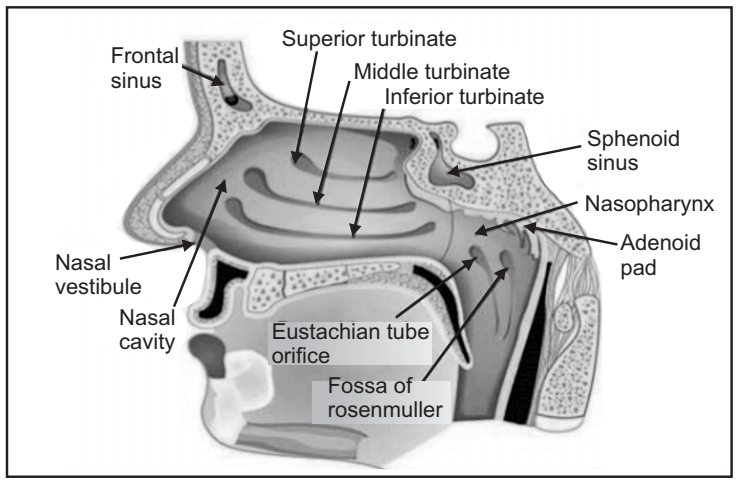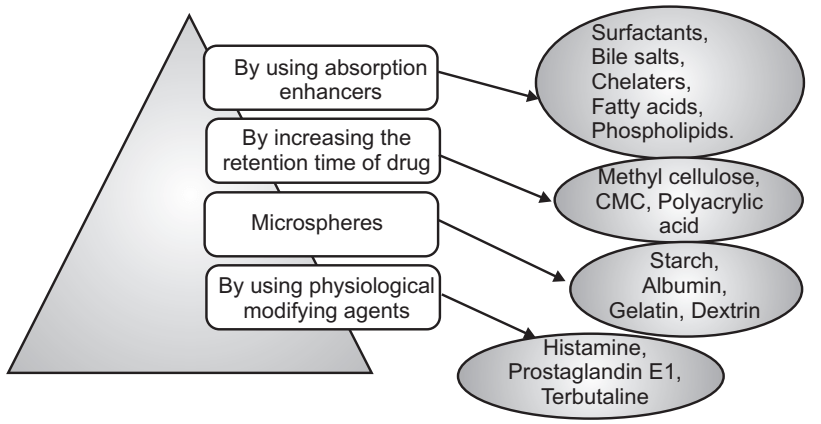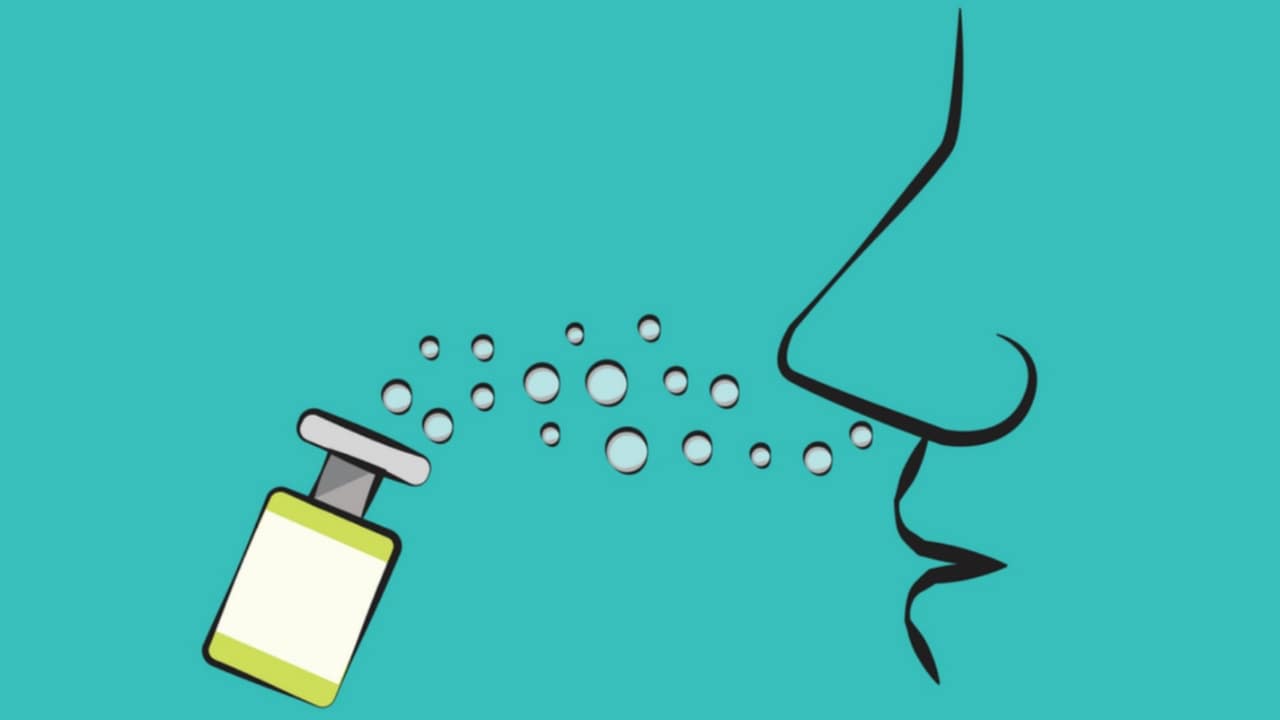Nasal drug delivery system – which has been practiced for thousands of years, has been given a new lease of life. The nasal drug delivery system is a useful delivery method for drugs that are active in low doses and show no minimal oral bioavailability such as; proteins and peptides. One of the reasons for the low degree of absorption of peptides and proteins via the nasal route is a rapid movement away from the absorption site in the nasal cavity due to the mucociliary clearance mechanism.
Nasal mucosa has been considered as a potential administration route to achieve a faster and higher level of drug absorption because it is permeable to more compounds than the gastrointestinal tract due to lack of pancreatic and gastric enzymatic activity, neutral pH of the nasal mucus, and less dilution by gastrointestinal contents. Many drugs have been shown to achieve better systemic bioavailability through nasal route than by oral administration. Nasal therapy has been a recognized form of treatment in the Ayurvedic systems of Indian medicine, it is also called “NASAYA KARMA”.
It has been documented that nasal administration of certain hormones and steroids has resulted in more complete absorption. This indicates the potential value of the nasal route for administration of systemic medications as well as utilizing this route for local effects. For many years’ drugs have been administered nasally for both topical and systemic action. Topical administration includes the treatment of congestion, rhinitis, sinusitis, and related allergic or chronic conditions, and has resulted in a variety of different medications including corticoids, antihistamines, anticholinergic, and vasoconstrictors.
Anatomy And Physiology of Nasal Cavity
Table of Contents
The nasal cavity is divided into two halves by the nasal septum and extends posterior to the nasopharynx, while the most anterior part of the nasal cavity, the nasal vestibule, opens to the face through the nostril. The nasal cavity consists of three main regions, i.e. nasal vestibule, olfactory region, and respiratory region. The surface area in the nose can be enlarged about 150 cm by the lateral walls of the nasal cavity which includes a folded structure, it is a very high surface area compared to its small volume. This folded structure consists of three turbinates: the superior, the median, and the inferior. The main nasal airway has narrow passages, usually 1-3 mm wide, and these narrow structures are useful to the nose to carry out its main functions. The nasal cavity is covered with a mucous membrane which can be divided into two areas; non-olfactory and olfactory epithelium. The nonolfactory area includes the nasal vestibule which is covered with skin-like stratified squamous epithelium cells, the respiratory region, which has a typical airways epithelium covered with numerous microvilli, resulting in a large surface area available for drug absorption and transport. In this way, the mucus layer is propelled in a direction from the anterior towards the posterior part of the nasal cavity. The goblet cells are present in the mucus membrane which covers the nasal turbinate and the atrium; it secretes the mucus as mucus granules which are swelling in the nasal fluid to contribute to the mucus layer.

Normal pH of the nasal secretions in Adults: 5.5-6.5; Infants and Young Children: 5.0-6.7. The Nasal Cavity is covered with a mucous membrane. Mucous secretion is composed of 95% water, 2% Mucin, 1% Salts, 1% of other proteins such as Albumin, Lysozyme, and Lactoferrin, and 1% Lipids.
Mechanism of Drug Action of Nasal Drug Delivery System
Paracellular (Intercellular): Slow and passive absorption of peptides and proteins associated with intercellular spaces and tight junctions.
Transcellular: Transport of lipophilic drugs passive diffusion/active transport.
Transcytotic: The particle is taken into a vesicle and transferred to the cell.


Advantages of Nasal Drug Delivery System
- Drug degradation that is observed in the gastrointestinal tract is absent.
- Hepatic first-pass metabolism is avoided.
- Rapid drug absorption and quick onset of action can be achieved.
- The bioavailability of larger drug molecules can be improved using an absorption enhancer or other approach.
- The nasal bioavailability for smaller drug molecules is good.
- Drugs that are orally not absorbed can be delivered to the systemic circulation by nasal drug delivery.
- Studies so far carried out indicate that the nasal route is an alternative to the parenteral route, especially, for protein and peptide drugs.
- Convenient for the patients, especially for those on long-term therapy, when compared with parenteral medication.
- Drugs possessing poor stability in G.I.T. fluids are given by nasal route.
- Polar compounds exhibiting poor oral absorption may be particularly suited for this route of delivery.
Disadvantages of Nasal Drug Delivery System
- The histological toxicity of absorption enhancers used in the nasal drug delivery system is not yet clearly established.
- Relatively inconvenient to patients when compared to oral delivery systems since there is a possibility of nasal irritation.
- The nasal cavity provides a smaller absorption surface area when compared to GIT.
- There is a risk of local side effects and irreversible damage of the cilia on the nasal mucosa, both from the substance and from constituents added to the dosage form.
- Certain surfactants used as chemical enhancers may disrupt and even dissolve membranes in high concentrations.
- There could be a mechanical loss of the dosage form into the other parts of the respiratory tract like lungs because of the improper technique of administration.
The different approaches:
1. Prodrug Approach: The absorption of peptides like angiotensin II, Bradykinin, Vasopressin, and Calcitonin is improved when prepared into enamine derivatives.
2. Structural Modification: Chemical modification of Salmon Calcitonin to elcatonin (C-N bond replaces the S-S bond) showed better bioavailability.
3. Particulate drug Delivery:
- Microspheres, Nanoparticles, and Liposomes.
- Nasal Enzyme Inhibitors.
- Peptides and Proteases.
- Trippin Aprotinin, Borovaline, Amastatin, Betaststin, and Boroleucin inhibitors.
The Components of the Nasal Formulations:
- Drug – Terbutaline sulfate.
- Viscosifying Agents – Hydroxypropyl cellulose.
- Solubilizers – Glycol, Alcohol, Cyclodextrins.
- Surfactants – SLS, Polyacrylic acid.
- Bio-adhesive Polymers – Methylcellulose, Carboxymethylcellulose.
- Preservatives – Parabens, Benzalkonium chloride.
- Antioxidants – Sodium metabisulphite.
Nasal Formulations
1. Nasal Gels: These are highly viscous, thickened solutions or suspensions. These have the following advantages:
- Reduction of post-nasal drip due to high viscosity.
- Reduction of taste impact due to reduced swallowing.
- Reduction of anterior leakage of the formulation. These are useful as there is the reduction of irritation by using emollient excipients.
2. Nasal Drops: These are simple and convenient systems developed for nasal delivery. The main disadvantage of this system is the lack of dose precision and therefore nasal drops may not be suitable for prescription products. It has been reported that nasal drops deposit Human Serum albumin in the nostrils more efficiently than nasal sprays.
3. Nasal Ointments: These are translucent, homogenous, viscous, semi-solid preparations intended to be instilled in the nose. Due to their viscosity, they will not ooze out of the nose.
4. Nasal Sprays: Solution and Suspension formulations can be formulated into nasal sprays. Due to the availability of metered-dose pumps and actuators, a nasal spray can deliver an exact dose from 25-200 µm. The particle size and morphology (for suspensions) of the drug and viscosity of the formulation determine the choice of pump and actuator assembly.
5. Nasal Powder: This dosage form may be developed if solution and suspension dosage forms cannot be developed. E.g. due to lack of drug stability.
The advantages of the nasal powder dosage form are the absence of preservatives and superior stability of the formulation. However, the suitability of powder formulation is dependent on the solubility, particle size, aerodynamic properties, and nasal irritancy of the active drug and/or excipients. Local application of the drug is another advantage of this system.
6. Liposomes: Liposomal nasal solutions can be formulated as a drug alone or in combination with pharmaceutically acceptable excipients. They are administered to the respiratory tract as an aerosol or solution for a nebulizer, or as a microfine powder for insufflation, above or in combination with an inert carrier such as; lactose, the particles of the formulation have diameters of less than 50 microns.
7. Microspheres: The main usefulness of a specialized system in designed nasal products is that it prolongs the contact with the nasal mucosa. The microspheres in their powder form swell in contact with nasal mucosa to form a gel and control the rate of clearance from the nasal cavity. Thus, increases the absorption and bioavailability by adhering to the nasal mucosa and increases the nasal residence time of the drug. The ideal microsphere particle size requirement for nasal delivery should range from 10-50 µm as smaller particles.
Applications of Nasal Drug Delivery System
- Delivery of non-peptide pharmaceuticals. E.g. Adrenal corticosteroids, Hormones like Progesterone, Vitamin, Cardiovascular drugs, etc.
- Delivery of peptide-based pharmaceuticals. E.g. Insulin, Calcitonin, Pituitary hormones.
- Delivery of diagnostic agents. E.g. Phenolsulfonphthalein is used to diagnose kidney function.
- Delivery of vaccines through nasal route. E.g. Anthrax and Influenza are treated by using nasal vaccines.
- Delivery of drugs to the brain through the nasal cavity. E.g. Parkinson’s disease, Alzheimer’s disease.
Make sure you also check our other amazing Article on : Transdermal Drug Delivery System
